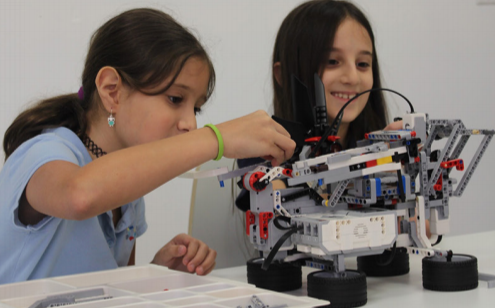
"The last few decades have belonged to a certain kind of person with a certain kind of mind–computer programmers who could crank code, lawyers who could craft contracts, MBAs who could crunch numbers. But the keys to the kingdom are changing hands. The future belongs to a very different kind of person with a very different kind of mind–creators and empathizers, pattern recognizers and meaning makers. These people-artists, inventors, designers, storytellers, caregivers, consolers, big-picture thinkers–will now reap society’s richest rewards and share its greatest joys.”
- Daniel Pink
The STEM program is incorporated STEM into our K-8 curriculum. At The Jewish Academy, our students build their own Lava Lamps, learn how to develop their own Apps for iphone and android, coding language, build their own websites for Jewish Values, and visit local places of technology and innovation. Many choose to participate in our Robotics Club after school, which brings the elements of fun and competition to their learning. At TJA we believe that it is imperative for students to learn to leverage technology in order to compete in the global economy.
In the minds of today’s students, technology is not a subject to be learned, but rather the means through which they can achieve their curricular goals. Technology at the Jewish Academy is used as a tool to enhance the learning experience. The use of technology as an effective teaching and learning tool is a key curricular and instructional focus that is exciting and engaging to both students and faculty.
Technology becomes an organic aspect of learning integrated within the classroom curriculum. Our students have available to them an extensive array of devices situated throughout the building. The Jewish Academy is a Google School, using Google Apps beginning in grade one. Google Apps is a free suite of hosted email and collaboration applications available exclusively for schools and universities. Each student from grade one and up is provided with his or her own email address. Students in first and second grade can access their personal Google Drive accounts without being exposed to email. Students use Google Drive to create cloud-based documents that can be shared with teachers or fellow students, allowing for collaboration. These documents are accessible wherever there is Internet access, allowing for easier transition between school and home. As the students become more comfortable with Google Apps, they expand their Google portfolios to include documents, spreadsheets, slides, drawings, and even Google Sites, a website creator.
One of the most important skills of the 21st century is digital literacy. At the Jewish Academy, students are taught how to safely and effectively surf the Internet, as well as how to evaluate the veracity of a website. Our digital citizenship curriculum provides students with the scaffolding they need to develop a good online reputation and become good digital citizens, while at the same time, protect themselves online.
As technology evolves, so do the experiences provided to our children.
Some examples are:

Digital storytelling
Digital citizenship
Web-enabled reading and reading-readiness software
Web-enabled keyboarding tutor
Green screen technology
Video editing
Animated video creation

Photo editing
Podcasting
Collaborative learning with students in Israel
Distance learning
Apple collaboration including field trip to Apple Store
Online presentation tools
ePortfolios
Professional development is an intricate part of The Jewish Academy's mission. Our staff members attends workshops, seminars, webinars, and other enhancing opportunities. This ensures that our staff continues to develop vital tools and skills that can be passed on to our students.
Presently, our teachers are involved in several global learning opportunities where one can connect with and learn from educators from around the world. Innovations will be born, our teachers will become co-learners, co-leaders, and co-constructors of knowledge. Together, this community of educators will continue to learn how to meet the needs of the 21st Century learner.





